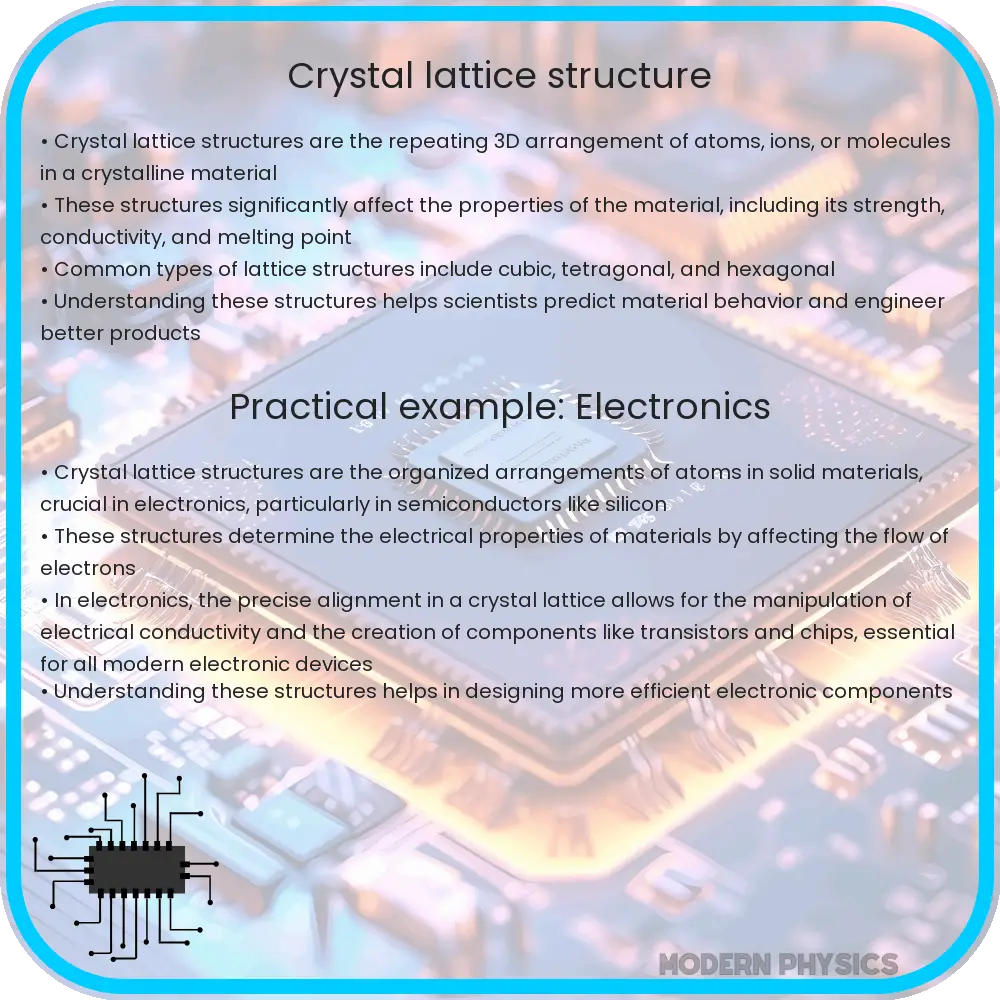Explore the fundamentals of crystal lattice structures, their types, analysis techniques, and impact on material properties and technology.

Understanding Crystal Lattice Structures: An Overview
Crystal lattice structures form the backbone of material science and solid-state physics. These structures, defined by a regular arrangement of atoms, ions, or molecules, profoundly influence the properties and behaviors of crystalline materials. This article delves into the intricacies of crystal lattice structures, examining their mechanics, analysis, and overall form.
The Basics of Crystal Lattice Structure
At the core of a crystal lattice structure lies the concept of a unit cell. This smallest repeating unit, akin to a building block, defines the entire crystal’s structure. A crystal lattice can be visualized as a three-dimensional grid, where each point (lattice point) represents the position of an atom, ion, or molecule. The symmetry and spatial arrangement of these lattice points classify crystals into different lattice systems and Bravais lattices.
Types of Crystal Lattices
Crystal lattices are broadly categorized into seven crystal systems: cubic, tetragonal, orthorhombic, hexagonal, rhombohedral, monoclinic, and triclinic. Each system is defined by specific geometrical parameters such as lattice constants and angles. Within these systems, there are 14 distinct Bravais lattices, further delineating the arrangements in three-dimensional space.
Analysis and Characterization
To analyze crystal lattice structures, several techniques are employed. X-ray diffraction (XRD) is paramount, providing critical information about lattice dimensions and symmetry through the diffraction pattern. Electron microscopy and neutron diffraction are also instrumental in examining finer details of the lattice.
Crystal Lattice Mechanics
The mechanical properties of materials, such as strength, ductility, and hardness, are significantly influenced by their crystal lattice structure. Dislocations, defects within the lattice, play a pivotal role in determining these properties. The study of these dislocations and how they interact with the lattice under various conditions like stress and temperature is crucial in understanding material behavior.
Applications and Importance
Crystal lattice structures are not just theoretical constructs but have practical applications in various fields. Semiconductors, for instance, rely heavily on the precise arrangement of atoms in their crystal lattice to function effectively. Similarly, the development of new materials for construction, electronics, and medicine often begins with a deep understanding of crystal lattice structures.
Advanced Concepts in Crystal Lattice Structures
The exploration of crystal lattice structures extends into advanced territories like Band Theory and Phonon Studies. Band theory explains how the energy levels of electrons in a crystal form bands, influencing electrical conductivity. Phonons, on the other hand, represent the quantized modes of vibrations within the lattice, affecting thermal properties and heat capacity.
Crystal Defects and Material Properties
Beyond perfect lattices, real-world materials exhibit various defects such as vacancies, interstitials, and grain boundaries. These imperfections have a profound impact on material properties, often enhancing or diminishing specific characteristics. For instance, doping semiconductors with impurities alters the crystal lattice to modify electrical conductivity.
Computational Modeling of Crystal Lattices
In the digital age, computational modeling has become a powerful tool in studying crystal lattice structures. Techniques like Density Functional Theory (DFT) and Molecular Dynamics (MD) simulations provide insights into the behavior of materials at an atomic level. This computational approach is essential in predicting material properties and guiding the synthesis of new materials.
Environmental and Industrial Implications
Understanding crystal lattice structures has significant implications for environmental sustainability and industrial applications. For instance, the development of photovoltaic materials for solar panels heavily relies on the understanding of crystal lattice structures. Similarly, advancements in catalyst design for chemical processes are often based on lattice structure analysis.
Conclusion: The Pinnacle of Material Science
The study of crystal lattice structures is at the heart of material science and solid-state physics. It provides a fundamental understanding of how materials behave and interact at the atomic level. From the simplest crystal lattices to the most complex defects, the comprehensive analysis of these structures shapes our approach to developing new materials and technologies. As we continue to explore the intricacies of crystal lattices, we pave the way for innovations that will revolutionize industries and enhance our daily lives.
